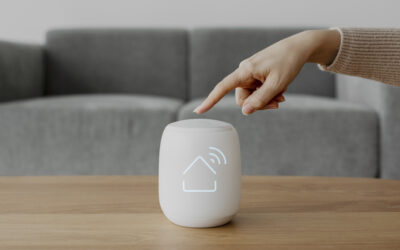Table of Content
- What is BLE Mesh?
- Key Advantages of BLE Mesh
- How Mesh Topology Works in Bluetooth Mesh Networks
- BLE Mesh Applications
- Mesh Profile Functionality
- BLE Mesh Security
- Optimizing Bluetooth Mesh Networks
- Bluetooth Mesh Hardware Components
- Krasamo’s Key Competitive Advantages
BLE modules applications are increasing with the accelerated growth of IoT markets.
With the rapid growth of IoT, there is a growing demand for low-power wireless communication solutions that can support large-scale networks. Bluetooth Low Energy (BLE) is a technology that provides a promising solution, allowing devices to transfer data wirelessly to other devices while consuming a minimal amount of power. BLE uses the 2.4 GHz ISM spectrum band and offers high-speed data transfer within a personal area network (PAN). However, traditional Bluetooth technology has limitations when supporting large-scale node networks. Bluetooth mesh is a new topology that sits on top of BLE and addresses this limitation, providing a scalable and reliable solution for IoT applications.
This article will overview Bluetooth mesh networks, their key advantages, applications, and security features. We will explain how Bluetooth mesh works, how messages are relayed, how devices are provisioned, and how the security process works. We will also provide specific examples and case studies of Bluetooth mesh networking applications, such as commercial lighting, asset tracking, and building automation. Additionally, we will discuss the importance of BLE modules, their specifications, capabilities, limitations, and their applications in IoT devices. By the end of this article, readers will have a comprehensive understanding of Bluetooth mesh networking and its potential for IoT applications.
Bluetooth is becoming an industry standard for mesh networking.
Bluetooth has quickly become the industry standard for mesh networking. Thanks to its versatility, Bluetooth mesh has enabled the development of a wide range of mobile applications for IoT products that work with BLE modules. These modules are embedded into devices, sensors, and equipment and are natively supported by popular operating systems such as iOS, Android, and Windows. In addition, operating systems provide APIs that support Bluetooth LE and mesh profile specifications or communicate through the mesh proxy protocol. This has opened a world of possibilities for developers, allowing them to create innovative applications that leverage the extended coverage range and enhanced connectivity of Bluetooth mesh networks. As a result, the demand for BLE modules and Bluetooth mesh networking solutions is growing rapidly. It is set to revolutionize the way we interact with IoT devices in the future.
Krasamo designs and develops firmware, mobile apps, and processes that connect with IoT ecosystems.
If you are looking to develop IoT products or integrate IoT technologies into your business operations, you must learn about BLE mesh.
What Is BLE Mesh?
BLE mesh is a cutting-edge networking technology built on top of Bluetooth Low Energy (BLE) standards. Designed for IoT and Smart Buildings, BLE mesh provides a robust and scalable solution for wireless communications that covers larger areas and keeps data safe.
One of the key benefits of BLE mesh is its many-to-many network topology, which allows devices to communicate with any other device within range, thus extending the network range beyond individual nodes or devices. This means that BLE mesh networks can support a large number of devices over a wide area, making it a perfect solution for smart buildings, smart cities, and industrial applications.
Furthermore, BLE mesh offers enhanced security through encryption keys (network keys), allowing new devices to be provisioned without affecting other nodes. This means that BLE mesh networks are designed to keep data safe, making them an ideal choice for applications requiring high security levels.
Compared to other networking technologies, BLE mesh offers several advantages. For example, BLE mesh is designed to have low power, meaning it can operate on a single battery for extended periods. Additionally, BLE mesh is compatible with Bluetooth version 4.0 and higher, making it a relevant technology for modern devices.
Overall, BLE mesh is a powerful and versatile networking technology that offers a range of benefits and advantages over other networking technologies. Its many-to-many network topology, enhanced security features, and low-power operation make it well suited for applications where many devices must communicate.
BLE mesh is optimized for large device networks that require communication among devices.
Key Advantages of BLE Mesh

Industrial Grade Solution—reliable, scalable, and secure

Extended connection range

Interoperability between different manufacturers


Bluetooth networking protocols with comprehensive APIs and Bluetooth mesh SDKs


How Mesh Topology Works in Bluetooth Mesh Networks
Mesh Topology
A mesh topology network features many-to-many communication between all nodes. In Bluetooth mesh networks, nodes are Bluetooth devices equipped with a Bluetooth Low Energy (BLE) module, enabling communication within the network.
Each node or “element” has a unique ID and communicates directly or indirectly through other nodes. For example, messages are sent to specific nodes or broadcast to all nodes. Also, messages can be stored a delivered later.
Messages Relay
In mesh networks, devices utilize a mesh networking algorithm to relay messages between nodes not in direct radio range, allowing communication even without a direct connection. This message relay process extends the network’s range and is a significant advantage of mesh networking.
When sending a message, a device first checks if the destination device is within range. If so, the message is sent directly. If not, the message is relayed through devices closer to the destination until it is delivered.
Mesh networks are ideal for applications with devices distributed across large areas, such as smart homes, smart cities, and industrial automation. Additional benefits of message relays in mesh networks include increased network range, improved reliability, reduced congestion, and energy conservation. These features make mesh networks a valuable solution for various applications.
Provisioning—How New Devices Join a Mesh Network
New devices join a mesh network through a secure provisioning process using encryption keys (network keys), forming a node communicating with uniquely identified elements via messages. The provisioning process involves two key types: the Network Key (NetKey) and the Application Key (AppKey).
The NetKey is a shared secret to secure the network, while the AppKey encrypts and decrypts messages. During provisioning, a new device receives a NetKey and, if authorized, an AppKey to communicate with the network. This ensures a secure method for adding devices to the mesh network without affecting other nodes.
Provisioning configures devices to join a network, providing them with a NetKey and an AppKey. The NetKey encrypts all network traffic, while the AppKey manages message encryption and decryption between the device and the network. Once provisioned, devices can join the network and communicate with others.
The secure provisioning process, which uses a shared secret (NetKey) to encrypt network traffic, prevents unauthorized devices from intercepting or tampering with messages. Additional benefits of the provisioning process include allowing devices to join without affecting other nodes, providing a secure way to add new devices, and facilitating easy network management. Provisioning is a crucial aspect of any mesh network, ensuring its security and seamless addition of new devices.
Security
Security is a crucial aspect of Bluetooth mesh networking, and BLE mesh employs authentication, encryption, and obfuscation mechanisms to ensure secure communications. For example, encrypting all messages with 128-bit AES encryption and using network/application keys makes it difficult for attackers to track or intercept messages.
BLE mesh also provisions devices without impacting other nodes, with each device’s states and properties having specific characteristics. Access control lists (ACLs) regulate access to these characteristics, enhancing security.
Bluetooth mesh networking offers a secure, scalable, and efficient solution for extensive node networks. Secure provisioning enables seamless addition of new devices without affecting existing ones, while encryption and access control mechanisms ensure message security and regulated access to device characteristics.
BLE Mesh Applications
BLE mesh networking has been growing thanks to its capabilities, interoperability, and secure communication of many-to-many devices. The following application categories are ideal for developing a Bluetooth mesh network:
- Commercial Lighting
- Beaconing—Asset Tracking
- Sensors—Sensor Network Solutions
- Building Automation
- Industrial Automation
- Smart Warehouse
A Krasamo IoT technical team is available to discuss your company’s business case and how we can help you design a specific BLE mesh.
Mesh Profile Functionality
Bluetooth mesh networking testing is critical for any IoT deployment to comply with the mesh profile specifications of functional requirements in scope. Testing a mesh profile functionality to verify node interoperability ensures provisioning within the mesh network. Testing performs test cases according to the mesh profile test suite.
- Profile qualification and interoperability testing
- Core host and protocol testing
- Signal generation and analysis
- Verification of features
- Valid behavior (VB) tests and invalid behavior (IB) tests
- Automate Bluetooth measurements with API to connect with IDE
The Bluetooth Test Case Reference List (TCRL) documents all the test cases required to qualify products and their supported capabilities.
To further support your IoT project, our team can provide:
Detailed Explanation of Test Cases: Comprehensive information about each test case, what they are designed to evaluate, and why they are essential for ensuring the functionality and interoperability of the mesh network.
Step-by-Step Testing Procedure: Procedures on how testing is conducted, including setting up the environment, conducting tests, interpreting results, and troubleshooting issues.
Interpreting and Applying TCRL: Advice on interpreting and applying the Bluetooth Test Case Reference List (TCRL) during product development and testing processes.
Information on Automating Measurements: Guidance on implementing APIs to automate Bluetooth measurements and technical details about their functionality.
Case Studies or Examples: Sharing experiences from real-world examples of Bluetooth mesh networks that went through these testing processes and their outcomes.
Common Issues and Troubleshooting Tips: Discuss common issues encountered during testing and their solutions.
Updates and Future Developments: Information on the latest updates in Bluetooth mesh testing and anticipated future developments.
BLE Mesh Security
Securing devices, software, and the stack is vital for the evolution and success of the Internet of Things and BLE mesh networks. BLE mesh provides authentication, encryption, and obfuscation of secure communications.
BLE mesh encrypts all messages, assigning a unique address to each node by the provisioner. Messages sent through the network are difficult to track, as they use obfuscation mechanisms with 128-bit AES encryption and network/application keys to protect against attacks.
- Network Key (NetKey) secures network layers across all nodes.
- Application Key (AppKey) is used to encrypt/decrypt messages.
(AppKeys are also used to differentiate between applications.) - Device Key is a random unique ID known by the device and the provisioner.
The security process is performed by provisioning a security model designed with consideration of devices, application layer, selected platform, firmware, and communication.
Optimizing Bluetooth Mesh Networks
Bluetooth mesh network stack performance and behavior are tested for throughput, security, latency, and reliability. Bluetooth mesh, Thread, and Zigbee are usually compared to determine the most appropriate for the device or application, also considering networks that work with low power and are battery-operated. Recommendations depend on their specific usage, requirements, and type of facility.
Bluetooth performs well on latency—it uses a flooding message technique to relay messages, and latency depends on network size and packet payloads. Latency increases as the network nodes and payloads increase. Managing the number of relays improves performance.
It is worth evaluating the IoT ecosystem, interfaces, and cloud connectivity to find the best fit for the scenario and technology available. Multiprotocol chips that support various protocols are ideal for gateway applications.
Bluetooth Mesh Hardware Components
A comprehensive understanding of various components used in the design and implementation of integrated systems, with a particular emphasis on Bluetooth and IoT devices, is necessary.
Integrated Circuits
System on Chip (SoC): A System on a Chip (SoC) is an integrated circuit (IC) that consolidates all components of a computer or other system into a single chip for maximum efficiency. SoCs are embedded into devices to perform specific functions, such as managing the device’s memory, executing system tasks, or handling graphic processing. Control programs for these tasks are written directly onto the SoC.
Microcontroller (MCU): A microcontroller is another type of IC, typically containing one or more processors (CPUs), a small amount of RAM, and flash memory. Because of their self-sufficiency, MCUs are often used in purpose-built applications, as they require fewer external components and can interface with external devices through serial communication buses. Common MCU processors include the ARM Cortex-M4 and ARM Cortex-M3.
Bluetooth Components
Bluetooth Low Energy (BLE) Module: A BLE module is a key component in any Bluetooth network. These modules are assembled circuits consisting of a chipset, an integrated RF module, a controller, an API processor, and other components tailored to specific applications. BLE modules come in two forms: single-mode, which only supports low-energy operations, and dual-mode, which can support traditional Bluetooth and BLE operations.
Radio Frequency Components
RF Modules: RF modules are integral for transmitting radio signals between devices in embedded systems. They are used in systems requiring medium or low data rates and are designed to comply with Bluetooth Low Energy (BLE) communication protocols.
RF Wireless Boards: RF wireless boards, often called printed circuit boards (PCBs), are sheets of copper laminated onto a non-conductive substrate. They are used to wire and secure components such as capacitors, resistors, and ICs. In addition, in the context of wireless communication, they often house RF modules and other related components.
Signal Processing
Mixed-signal ICs: Mixed-signal ICs are a type of integrated circuit that can handle both analog and digital signals. They’re crucial in systems that convert analog signals to digital ones or vice versa. This capability enables seamless functionality and interconnection between different signal types within a system.
Sensors and Development Boards
Sensors: In IoT and Bluetooth systems, sensors are the primary data collection points. They can measure various physical or environmental conditions, including temperature, pressure, humidity, proximity, and voltage. This data can then be communicated to MCUs via Bluetooth, making sensors crucial for designing interoperable IoT modules that comply with Bluetooth protocol specifications.
Development Boards: Development boards are hardware platforms for developing and prototyping electronic devices. They allow for easy interfacing between different subsystems and microcontrollers. Some development boards are designed to support multiple protocols and can connect to cloud services to upload and manage data. These boards simplify the design and testing process in developing IoT devices and Bluetooth systems.
Integrating these components allows one to design and implement efficient, secure, and reliable Bluetooth modules and IoT devices.
Krasamo’s Key Competitive Advantages
- Proficiency in Developing Mesh System Architectures
- Mastery of Firmware and System Design
- Expertise in Microcontroller, System on a Chip (SoC), and Module Integration
- Multiprotocol Connectivity Software Expertise
- Real-Time OS for IoT
- Security Integration Expertise
- Comprehensive Understanding of Mobile Apps, IoT Systems, and Trends
Krasamo’s engineering teams combine analog expertise with innovative problem-solving abilities to tackle complex IoT challenges. We prioritize close collaboration with our clients, adapting our approach to each unique project during development. This approach is customized based on specific client requirements and necessitates comprehensive communication. In addition, our seasoned application engineers provide complete support throughout the design process and product architecture development, accelerating the product’s time to market.
Learn more by consulting the Bluetooth Mesh Networking FAQs page.












I respectfully disagree – Bluetooth mesh isn’t the only solution for large-scale IoT deployments; my experience with other protocols proves that claim too narrow-minded 🤔